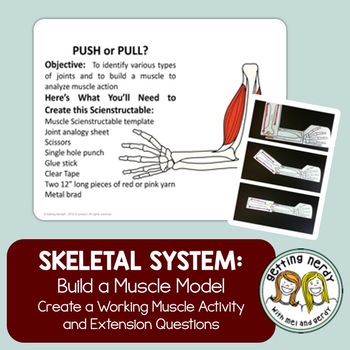Skeletal and Muscular System - Joint Model
- Zip
- Google Apps™

What educators are saying
Description
Show students that muscles always pull and never push with this easy to assemble and understand joint model for the skeletomuscular system.
WHAT'S INCLUDED in this 1 DAY MINI-BUNDLE:
• 6 slide fully-editable PowerPoint presentation with title slides, objectives, bell work and guided notes
• 5 NON-EDITABLE PDF pages which includes joint model template, instructions, answer key and extension questions
STUDENTS WILL:
• Follow the directions to cut-out and assemble working joint model
• Complete the extension questions
THIS PRODUCT IS ALSO FOUND IN OUR:
• Human Body Complete Bundle - PowerPoint Unit, INB, Task Card, Word Wall
• Life Science Biology Curriculum Bundle
CHECK OUT OUR OTHER HUMAN BODY PRODUCTS :
• Human Body Systems - Interactive Notebook Activity Pack
• Human Body Systems Bundle - STEAM Science Centers / Lab Stations
• Human Body Systems - Word Wall
• Human Body Systems - Task Cards
• Integumentary system - Human Body "I Have . . . Who Has?" Game/Activity
SEE HOW THIS LESSON ALIGNS WITH THE NGSS, TEKS or GSE
Because we have created many of our own graphics or have purchased licenses to other graphics with permission, we cannot offer our resources in editable format unless otherwise stated.
TERMS OF USE (TOU):
All rights reserved by GETTING NERDY®️
• This product is to be used by the original purchaser only
• Intended for classroom and personal use only
• Copying for more than one teacher, classroom, department, school, or school system is prohibited
• This product may not be distributed or displayed digitally for public view
Failure to comply is a copyright infringement and a violation of the Digital Millennium Copyright Act (DMCA). Clipart and elements found in this PDF are copyrighted and cannot be extracted and used outside of this file without permission or license.
Skeletomuscular System Joint Model © 2012 to present Getting Nerdy ®️ All Rights Reserved
www.gettingnerdyscience.com





